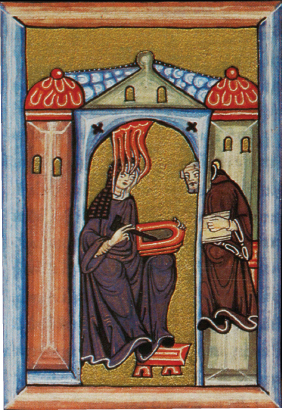Hildegard of Bingen (1098–1179), Plainchant sequence, “Columba aspexit”
To the Catholic Church she is St. Hildegard, venerated by a special liturgy on September 17. To musicians she is the first great woman composer. Five hundred years after Gregory I, the first compiler of Gregorian chants, Hildegard composed plainchant melodies in her own highly individual style, to go with poems that she wrote for special services at the convent of Bingen, in western Germany, under her charge as abbess. She also wrote a famous book describing her religious visions, books on natural science and medicine, even biographies.
“Columba aspexit” was composed in honor of a now-

Our recording includes an instrumental drone — a single two-
LISTEN
Hildegard of Bingen, “Columba aspexit”
| 0:02 | A | Columba aspexit | The dove entered |

A miniature illustration of Hildegard of Bingen, in one of her manuscripts, shows the miracle by which fire came down from heaven to engulf and inspire her. Her secretary, a monk named Volmar, looks on in wonder. Erich Lessing/Art Resource, NY.
|
| Per cancellos fenestrae | Through the lattices of the window, | |||
| Ubi ante faciem eius | Where, before its face, | |||
| Sudando sudavit balsamum | Balm emanated | |||
| De lucido Maximino. | From incandescent Maximinus. | |||
| 0:28 | A' | Calor solis exarsit | The heat of the sun burned | |
| Et in tenebras resplenduit; | And dazzled into the gloom, | |||
| Unde gemma surrexit | Whence a jewel sprang forth | |||
| In edificatione temple | In the building of the temple | |||
| Purissimi cordis benevoli. | Of the most pure loving heart. | |||
| 0:56 | B | Iste turis . . . | He is the high tower of Lebanon . . . | |
| 1:29 | B' | Ipse velox . . . | The swift hart sped to the fountain . . . | |
| 2:03 | C | O pigmentarii . . . | O you makers of incense . . . | |
| 3:15 | D | O Maximine . . . | O Maximinus . . . | |
| (two more stanzas) |